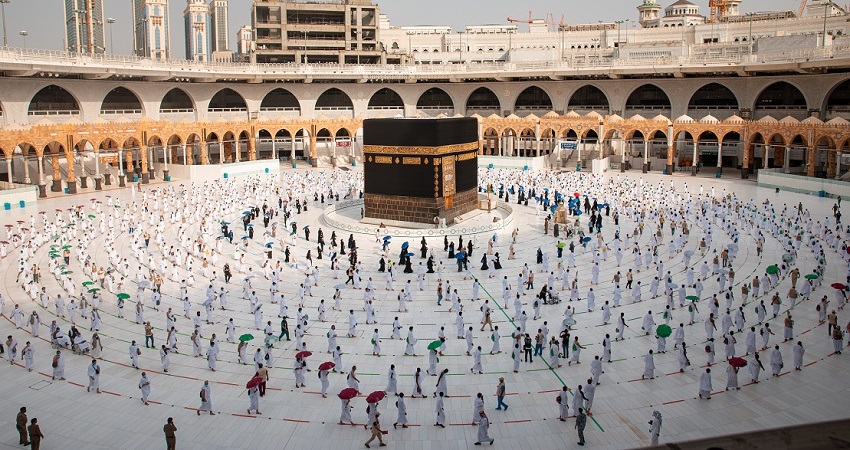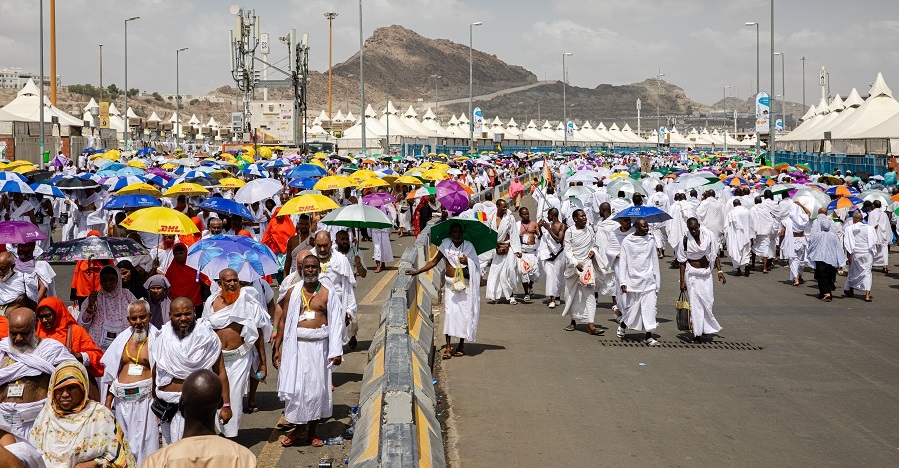The primary Muslim pilgrimage to Mecca is known as Hajj, which is not only an obligation but an aspiration of every Muslim. In the holy land of Saudi Arabia lies the sacred city of Mecca, where pilgrims gather in millions to atone for their sins, get blessings from the almighty and perform dua in praise of Allah. If planning for Hajj, it is crucial for every pilgrim to understand its significance in the culture and lives of Muslim brothers and sisters.
Hajj to Mecca
Hajj is an obligation for every person who believes in Prophet Muhammad, and one must carry it out at least once in a lifetime. It takes place in the last month mentioned in the Islamic calendar, and after its completion, the pilgrim is called Hajji or al-Hajj. Pilgrims carry out the rituals for about five or six days.
It is believed that the rituals of Hajj have remained unchanged since inception. Hajj, also known as the major Muslim pilgrimage to Mecca, continues to draw millions of people every year to the holy city of Mecca.
What is the purpose an annual pilgrimage to Mecca?
Hajj is an opportunity to wipe clean the past sins, shortcomings and mistakes so that one can make a fresh start. After performing Hajj, Prophet Muhammad said that one attains freedom from evils, lusts and immoral crimes to become as new as an infant.
People who are not financially strong or are incapable of performing the pilgrimage, can even attend it by proxy. Hajj Badal allows one to ask a relative to perform the pilgrimage in their place and pray to Allah to forgive the sins and bless the heart.
Significance of Hajj
The main purpose of Hajj, the main Muslim pilgrimage to Makkah is to awaken the senses of pilgrims and provide them with the realisation of the purpose of their birth. It symbolises humility by discarding races and classes between people and allows them to interact freely with one another. They believe that the season of Hajj brings good fortune for Muslims, who come together to praise the almighty.
The Pillars of Hajj: The Islamic culture stands on five pillars – faith (shahada), alms-giving (zakat), fasting (sawm), prayer (salah) and pilgrimage (Hajj). Irrespective of the ethnicity, sectarian differences and region, Muslims uphold these pillars and consider them obligatory for all males and females of Sunni and Shia communities.
The Story of Hajj
One can trace the history of Hajj to 2,000 B.C. According to the old testament, Prophet Ibrahim left his wife and son, Hajra and Ishamel, in the dunes of Mecca. In the deserted place, when Ishmael got dehydrated, Hajra ran between the two hills of Safa and Marwa in search of water.
At last, she prayed to God, and an angel from heaven struck the ground, opening a water spring in front of the mother and son. It is believed that Prophet Ibrahim got a word from Allah to build a sacred place near the spring. The father and son duo worked hard and built a stone building, called Kaaba.
As Prophethood was bestowed upon Ishmael, he spoke to the people around and asked them to surrender themselves to Allah. The water source that saved his life was called the well of ZamZam. Since then, Mecca became a sacred city where Prophet Ibrahim and after him, Prophet Ishmael came every year to perform Hajj.
Years went on, and the people of Mecca started believing in other Gods and worshipped spirits. According to legends, it was at this time that Prophet Muhammad received a word from Allah to restore the sanctity of Kaaba and spread the word to worship Him alone. Around 628 CE, Prophet Muhammad and his followers started their journey to Mecca, re-established the purity of Kaaba and restored the tradition started by Prophet Ibrahim. It was the first Islamic pilgrimage.
Rituals Of Hajj
The major Muslim pilgrimage to Mecca needs a minimum of six days to complete. Key rituals that all pilgrims must perform during Hajj are:
Day 1: Pilgrims walk from Mecca to Mina and spend the day in camps making Salah, listening to lectures and reciting Talbiyah.
Day 2: Pilgrims visit Mount Arafat. It is renowned because legends say that Prophet Muhammad gave his final sermon here.
Day 3: This is the Day of Sacrifice and the first day of Eid. It follows a series of rituals – Rami (pelting stones at Jamarah al-Aqaba, the largest pillar), Qurbani (sacrifice of a goat, camel, sheep or cow), Halq (men shave their heads) and Taqsir (women trim their hair) and Tawaf al-Ziyarah (circling the Kaaba).
Day 4: Stones are pelted on Jamarah al-Ula (smallest pillar), Jamarah al-Wusta (middle pillar) and Jamarah al-Aqaba (largest pillar). After each pelting, Dua is performed.
Day 5: The same ritual is repeated on day five along with Fajr, an obligatory prayer before leaving Mecca.
Day 6: People perform farewell Tawaf, also called Tawaf al-Wida (another seven circles around Kaaba). It is followed by two Rakats and drinking of water from the well of ZamZam.
7 Steps of the Hajj Pilgrimage
Before performing the Mecca pilgrimage, pilgrims must make niyat and wear Ihram at a miqat. Then the pilgrims enter the holy boundaries to reach Masjid Al-Haram and the holy Kaaba for Hajj. Upon reaching the Grand Mosque, one has to perform Umrah and then follow the prescribed rituals. Here is how Hajj is performed step by step.
1. While in Ihram, state the intentions to perform Hajj
Pilgrims should make another intention to perform Hajj; once they have completed the Umrah.
2. Reach Mina
After offering the Fajar prayers, pilgrims should head to Mina and spend an entire day praying and performing the rituals of Hajj – Zuhr, Asr, Maghrib, and Isha.
3. Head to Mount Arafat for performing Wafuq
On the 9th day of Dhu-al-Hijjah or the 2nd day of Hajj, pilgrims head to Mount Arafat from Mina. While traveling, one should recite Labbaik Allahumma Labbaik’s Tasbeeh. Upon reaching Mount Arafat, pilgrims are required to perform Duhr and Asr along with Qasar prayers near the Jabal al-Rahmah from midday to sunset. The act is called Waquf.
4. Travel to Muzadalifah
After sunset, pilgrims reach Muzadalifah for Maghrib and Asr prayers. One can rest until the night before Fajr’s prayers to prepare for the next morning’s ritual of pelting the Devil. Pilgrims take equal sized pebbles to throw at the Devil. On the 10th day, Dhu al-Hijjah pilgrims depart for Makkah to do Tawaf al-Ifadah & Saee before sunset. They must return to Mina to perform Rami, Nahr, and Halq.
5. Perform Rami
Pilgrims are required to complete Rami or the stoning of the Devil on the 11th, 12th, and 13th days of Hajj. Seven stones of similar sizes are thrown at Jamrat al-Aqabah at noon each day. All pilgrims must depart for Makkah before sunset on 12th of Dhu al-Hijjah.
6. Perform Nahr or animal sacrifice
The stoning ceremony is only completed with animal sacrifice. Pilgrims can buy a sacrifice coupon or voucher, indicating that a sacrifice has taken place in their name. A lamb or a camel are the two options for sacrificial animals. The animal is slaughtered, and its meat is packed and given to the poor in the countries of the Middle East.
7. Carry Out Halq and Taqsir
Men should shave or trim their hair completely. It is forbidden for women to shave their heads. Women can get one hair strand or one lock cut. The cutting of hair signifies one’s separation from the world and submission to Allah.
Best Time to go for Hajj
The journey of Hajj, the Mecca pilgrimage, starts in the Islamic month of Dhul-Hijjah, 2 months and 10 days after the end of Ramadan. Kaaba is the most sacred shrine in the Islamic culture, and it becomes the destiny during the pilgrimage. Muslims follow a lunar calendar to decide the period for Hajj and therefore the dates, according to the Gregorian calendar, vary every year. One must plan and apply for a Hajj visa accordingly.
Rules & Regulations for Hajj
The government of Saudi Arabia lays down certain regulations for all Hajj pilgrims. A few of these regulations are as follows:
- No pilgrim should enter the King Abdulaziz Airport in Jeddah for Hajj later than 4 Dhul-Hijjah of each year.
- All pilgrims are required to leave the Kingdom of Saudi Arabia after Hajj is over. They must not stay later than the 10th of Muharram.
- Depending on the country of residence, each traveller must present mandatory vaccination certificates.
- If a traveller loses the passport, he or she must inform the office designated to take care of their well-being during Hajj.
- One must not take outside food products in the land of Saudi Arabia.
Hajj 2022
Hajj 2022 saw pilgrims perform the holy pilgrimage after a break of two years. It has been a successful season but while maintaining the latest COVID protocols. The regulations for Hajj 2022 pilgrimage were strictly enforced to ensure the safety of all pilgrims. Besides these new guidelines, there are many rules and regulations for pilgrims aspiring for Hajj – the major Muslim pilgrimage to Mecca. From visa to health requirements to how to prepare, there is a lot for aspirants to know and learn before taking the pilgrimage. Keep reading to know more about the sacred Islamic pilgrimages of Hajj and Umrah.
Suggested Read: Saudi Arabia Announces E-Visa For Hajj And Umrah Pilgrimage
Hajj Pilgrimage to Mecca FAQs
Where is Hajj performed?
To perform Hajj, Muslims from different parts of the world come to the holy Kaaba in Masjid Al-Haram, which is located in the city of Makkah, Kingdom of Saudi Arabia.
What is the objective of the Hajj pilgrimage to Makkah?
The Hajj pilgrimage to the Kaaba in Makkah is one of the pillars of Islam. All Muslims must complete Hajj at least once in their lifetimes. It is performed with the purpose of strengthening faith and seeking forgiveness from Allah.
How long does it take to complete Hajj?
The Hajj pilgrimage takes 6-7 days to complete.
Can a woman perform Hajj alone?
The Ministry of Hajj, Saudi Arabia permits women of all ages to perform Hajj without a mahram only if they are traveling in a group.
How do Muslims prepare for Hajj?
Hajj is a strenuous journey, and also an expensive one for those coming to Saudi from distant countries. Hence, one must prepare financially, physically, mentally, as well as spiritually for Hajj pilgrimage to Makkah.
What is the Muslim pilgrimage to Makkah called?
The Muslim pilgrimage to Makkah is called the Hajj, which occurs yearly during the last month of the Hijri or Islamic calendar. Every year millions of Muslims from all around the world travel to Makkah, Islam’s holiest city, to participate in the world’s largest pilgrimage gathering. The main purpose of participating in Hajj is to bow down to the Almighty and seek pardon for all sins committed. It symbolises a new start ー a life without sins.
Who started the pilgrimage to Makkah?
According to historical sources, the pilgrimage to Makkah can be traced back to the life of Prophet Ibrahim. It is believed that Prophet Ibrahim’s son, Ishamel, got dehydrated once and Hajra, Ishamel’s mother and Prophet Ibrahim’s wife, prayed to the Almighty for water in the desert. A water spring opened up soon after an angel struck the ground. It was here when Prophet Ibrahim and his son built the Kaaba, which later on became a pilgrimage site.
What happens on the pilgrimage to Mecca?
Performing Hajj and the pilgrimage to Makkah works simultaneously. The pilgrims come together at Makkah to state their intentions for Hajj and dress in Ihram to get ready for Umrah. After Umrah at Makkah, they move to Mina and other places to complete other rituals for Hajj. The pilgrimage at Makkah is mainly to seek forgiveness for sins committed in the past. Hajj pilgrimage stretches over five days and is completed after the Tawaf al-Wida.
Can non-Muslims go to Makkah?
No, non-Muslims are denied entry to the holy cities of Makkah and Madinah. Only followers of Islam are allowed to enter Makkah and Madinah. A non-Muslim entry to the city of Makkah or Madinah can lead to heavy fines or deportation. Even the pilgrims are not allowed to overstay for long after the Hajj is over until and unless there is an emergency. All pilgrims must leave when their Hajj is over before the 10th day of Muharram.
What is in the black box in Makkah?
The black box called the Kaaba is the holiest shrine in the Islamic world located at the centre of the Masjid al-Haram. It is the Almighty’s abode, which attracts millions of pilgrims every year who walk around it. The Holy Kaaba is a cubicle construction that has a room inside it with the Black Stone, which pilgrims touch and kiss to do away with their sins. The whole construction is covered in a black and golden cloth called the Kiswah.
What is Umrah in Islam?
Umrah is a visit to the holy site of Makkah, but it is different from the Hajj as it can be performed at any time during the year. Hajj can only be done in the last month of the Islamic calendar. Umrah is a rather low-scale pilgrimage, which does not have extremely strict rituals. Umrah is performed to clear the sins of the past and seek forgiveness from God. Umrah can be performed more than once.









